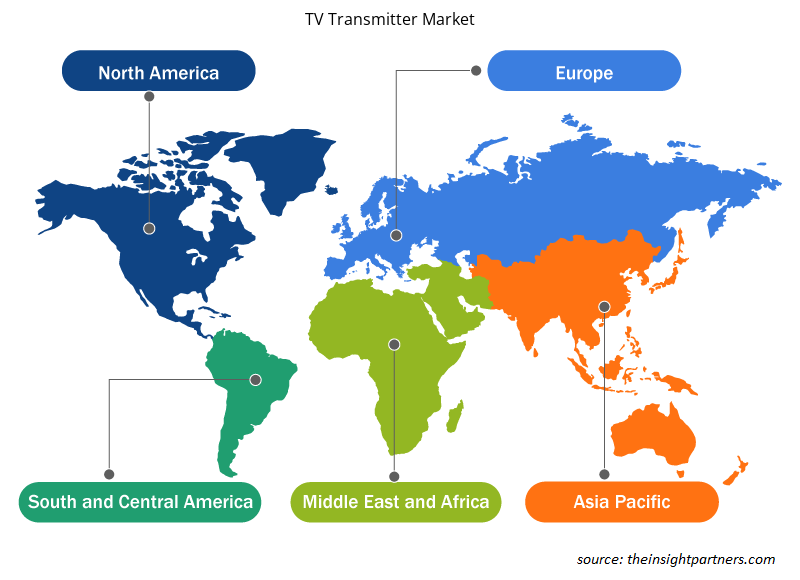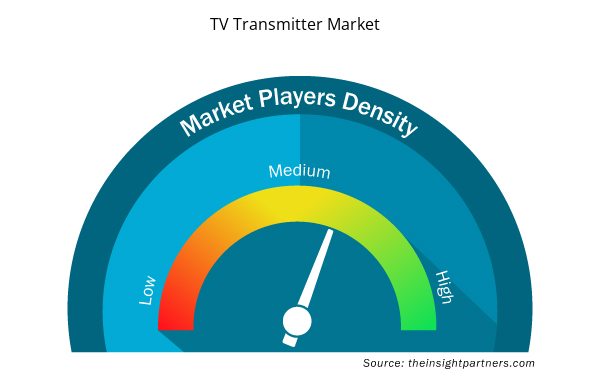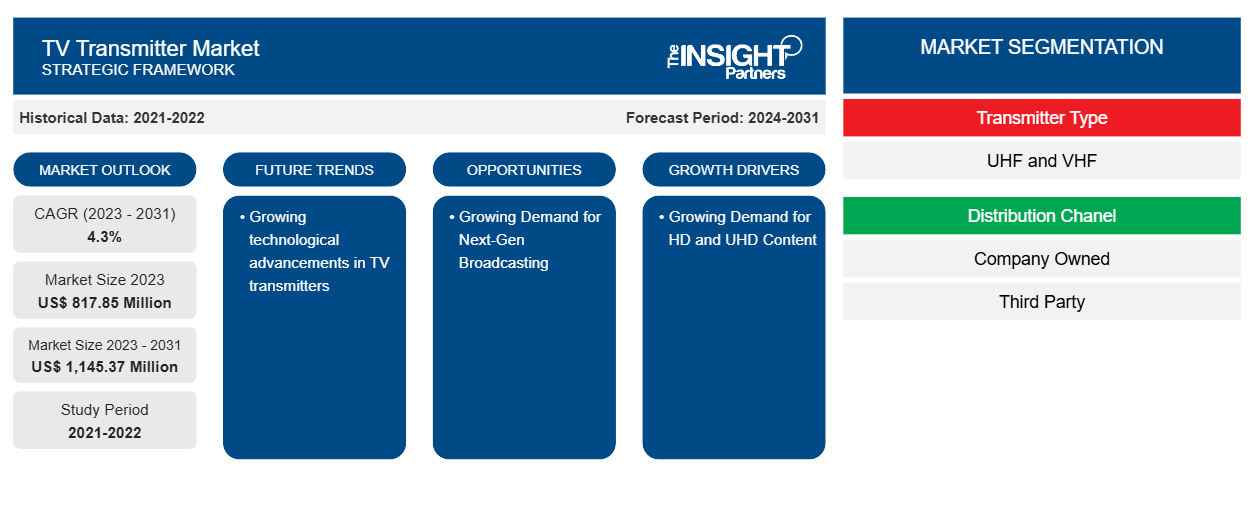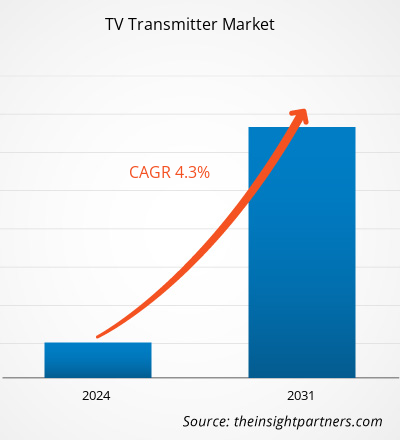テレビ送信機市場の規模は、2023年の8億1,785万米ドルから2031年には11億4,537万米ドルに達すると予測されています。市場は2023年から2031年にかけて4.3%のCAGRを記録すると予想されています。高精細コンテンツに対する需要の増加は、テレビ送信機市場の重要なトレンドであり続けると思われます。
テレビ送信機市場分析
世界中で高まるHDおよびUHDコンテンツの需要は、テレビ送信機市場の成長を牽引する主な要因の 1 つです。さらに、通信および放送部門における絶え間ない革新が、テレビ送信機市場の成長を牽引しています。さらに、次世代放送に対する需要の高まりは、予測期間中に市場の成長を後押しすると予想されます。さらに、テレビ送信機の技術進歩の高まりは、今後数年間でテレビ送信機市場の成長の機会を生み出しています。
テレビ送信機市場の概要
テレビ送信機は、動画像を表示するビデオ信号と、それに同期したオーディオ信号の両方を運ぶ電波を発信する電気機器です。テレビ受信機で受信され、画面に画像が表示され、一致する音が再生されます。動作周波数はVHFとUHF周波数帯に限定されており、出力は5Wから10kWの範囲です。テレビ局などのテレビ放送の分野で一般的に使用されています。
要件に合わせてレポートをカスタマイズする
このレポートの一部、国レベルの分析、Excelデータパックなど、あらゆるレポートを無料でカスタマイズできます。また、スタートアップや大学向けのお得なオファーや割引もご利用いただけます。
- このレポートの主要な市場動向を入手してください。この無料サンプルには、市場動向から見積もりや予測に至るまでのデータ分析が含まれます。
テレビ送信機市場の推進要因と機会
HDおよびUHDコンテンツの需要の高まり
高解像度 ( HD ) および超高解像度 ( UHD ) コンテンツに対する需要は、特に高品質のオーディオとビデオを提供することから、世界中の消費者の間で高まっています。さらに、高品質コンテンツのリリースに伴い、 OTTプラットフォームの使用が世界中で増加しています。このように、高品質コンテンツに対する需要の高まりが、テレビ送信機市場の成長を促進しています。
成長中次世代放送の需要
次世代放送にはデジタル放送規格の採用が含まれ、世界中のさまざまな地域で、米国のATSC 3.0、ヨーロッパの DVB-T2、アジアと南米の一部の地域のISDB-Tbなどの特定の規格が採用されています。これらの規格の利点には、オーディオとビデオの品質の向上、利用可能なスペクトルのより効果的な使用、新しいインタラクティブ機能の追加などがあります。デジタル放送規格への移行により、高解像度 ( HD ) および超高解像度 ( UHD ) の番組の送信が容易になり、視聴者ははるかに優れた視覚的および聴覚的体験を得て、テレビの楽しみが増えます。したがって、次世代放送の需要の高まりは、テレビ送信機市場の成長の機会を生み出すと予想されます。
テレビ送信機市場レポートのセグメンテーション分析
テレビ送信機市場分析の導出に貢献した主要なセグメントは、送信機の種類、流通チャネル、およびアプリケーションです。
- 送信機の種類に基づいて、テレビ送信機市場はUHFとVHFに分かれています。UHFセグメントは2023年に大きな市場シェアを占めました。UHFセグメントはさらに低、中、高に細分化されています。同様に、VHFセグメントはさらに低と中に分かれています。
- 流通チャネル別に見ると、市場は企業所有とサードパーティに分かれています。2023年には企業所有セグメントが市場で最大のシェアを占めました。
- アプリケーション別に見ると、市場は小規模テレビ局と大規模テレビ局に分かれています。2023年には大規模テレビ局セグメントが最大の市場シェアを占めました。
地域別テレビ送信機市場シェア分析
TV 送信機市場レポートの地理的範囲は、主に北米、アジア太平洋、ヨーロッパ、中東およびアフリカ、南米/中南米の 5 つの地域に分かれています。
収益の面では、アジア太平洋地域が最大の TV 送信機市場シェアを占めています。この地域の市場は、オーストラリア、中国、インド、韓国、日本、およびその他の APAC に分かれています。この地域の市場プレーヤーは、放送部門の技術革新に継続的に取り組んでおり、これがAPAC の TV 送信機市場の成長を促進する主な要因となっています。さらに、この地域ではメディアおよびエンターテイメント産業が驚異的な成長を遂げており、これが TV 送信機市場の成長をさらに促進しています。
テレビ送信機市場の地域別分析
予測期間を通じて TV 送信機市場に影響を与える地域的な傾向と要因は、Insight Partners のアナリストによって徹底的に説明されています。このセクションでは、北米、ヨーロッパ、アジア太平洋、中東、アフリカ、南米、中米にわたる TV 送信機市場のセグメントと地理についても説明します。

- テレビ送信機市場の地域別データを入手
テレビ送信機市場レポートの範囲
| レポート属性 | 詳細 |
|---|---|
| 2023年の市場規模 | 8億1,785万米ドル |
| 2031年までの市場規模 | 11億4,537万米ドル |
| 世界のCAGR(2023年~2031年) | 4.3% |
| 履歴データ | 2021-2022 |
| 予測期間 | 2024-2031 |
| 対象セグメント | 送信機タイプ別
|
| 対象地域と国 | 北米
|
| 市場リーダーと主要企業プロフィール |
|
テレビ送信機市場のプレーヤー密度:ビジネスダイナミクスへの影響を理解する
テレビ送信機市場は、消費者の嗜好の変化、技術の進歩、製品の利点に対する認識の高まりなどの要因により、エンドユーザーの需要が高まり、急速に成長しています。需要が高まるにつれて、企業は提供品を拡大し、消費者のニーズを満たすために革新し、新たなトレンドを活用し、市場の成長をさらに促進しています。
市場プレーヤー密度とは、特定の市場または業界内で活動している企業または会社の分布を指します。これは、特定の市場スペースに、その市場規模または総市場価値に対してどれだけの競合相手 (市場プレーヤー) が存在するかを示します。
テレビ送信機市場で事業を展開している主要企業は次のとおりです。
- ローデ・シュワルツ
- NEC株式会社
- 日立国際電気グループ
- BTESA
- エガテル
- ゲイツエア
免責事項:上記の企業は、特定の順序でランク付けされていません。

- テレビ送信機市場のトップキープレーヤーの概要を入手
テレビ送信機市場のニュースと最近の動向
テレビ送信機市場は、主要な企業出版物、協会データ、データベースを含む一次調査および二次調査後の定性的および定量的データを収集することによって評価されます。以下は、音声および言語障害および戦略の市場における動向のリストです。
- メディア配信ソリューションの大手プロバイダーであるENENSYS Technologiesとイタリアのテレビ送信機メーカーであるELECTROLINKは、イタリアの再農業プロジェクトに関連して、アブルッツォ州、ラツィオ州、リグーリア州で稼働しているすべてのDVB-T/T2送信機システムを、公開入札によって委託されたイタリアのライウェイに無事に納入したことを発表しました。ENENSYSとELECTROLINKはこのプロジェクトのために特別なパートナーシップを構築し、それぞれが最高のコンポーネントとエンジニアリングサービスを提供して、最も効率的で信頼性が高く最先端のDVB-T/T2送信システムをライウェイに納入しました。(出典:ENENSYS Technologies、プレスリリース、2023年)
- ホープ・チャンネル・セントラル・フィリピンは、フィリピンのセブ市にあるセントラル・フィリピン・ユニオン・カンファレンス(CPUC)本部に新しいスタジオと送信所を開設しました。(出典:アドベンチスト、プレスリリース、2023年)
テレビ送信機市場レポートの対象範囲と成果物
「テレビ送信機市場の規模と予測(2021〜2031年)」レポートでは、以下の分野をカバーする市場の詳細な分析を提供しています。
- 対象範囲に含まれるすべての主要市場セグメントの世界、地域、国レベルでの市場規模と予測
- 市場の動向(推進要因、制約、主要な機会など)
- 今後の主な動向
- 詳細なPEST/ポーターの5つの力とSWOT分析
- 主要な市場動向、主要プレーヤー、規制、最近の市場動向を網羅した世界および地域の市場分析
- 市場集中、ヒートマップ分析、主要プレーヤー、最近の動向を網羅した業界の状況と競争分析
- 詳細な企業プロフィール
- 過去2年間の分析、基準年、CAGRによる予測(7年間)
- PEST分析とSWOT分析
- 市場規模価値/数量 - 世界、地域、国
- 業界と競争環境
- Excel データセット


- Virtual Production Market
- Smart Water Metering Market
- Precast Concrete Market
- Small Molecule Drug Discovery Market
- Industrial Inkjet Printers Market
- Aircraft Wire and Cable Market
- UV Curing System Market
- Mobile Phone Insurance Market
- Single-Use Negative Pressure Wound Therapy Devices Market
- Skin Graft Market

Report Coverage
Revenue forecast, Company Analysis, Industry landscape, Growth factors, and Trends

Segment Covered
This text is related
to segments covered.

Regional Scope
North America, Europe, Asia Pacific, Middle East & Africa, South & Central America

Country Scope
This text is related
to country scope.
よくある質問
The global TV transmitter market was estimated to be US$ 817.85 million in 2023 and is expected to grow at a CAGR of 4.3% during the forecast period 2023 - 2031.
Growing demand for HD and UHD content are the major factors that propel the global TV transmitter market.
Growing technological advancements in TV transmitters are anticipated to play a significant role in the global TV transmitter market in the coming years.
The key players holding majority shares in the global TV transmitter market are Rohde and Schwarz, NEC Corp, Hitachi Kokusai Electric Group, BTESA, Egatel, Gates Air, Toshiba, Gospell Digital Technology Co., Ltd., Plisch, and Syes.
The global TV transmitter market is expected to reach US$ 1,145.37 million by 2031.
Trends and growth analysis reports related to Electronics and Semiconductor : READ MORE..
The Insight Partners performs research in 4 major stages: Data Collection & Secondary Research, Primary Research, Data Analysis and Data Triangulation & Final Review.
- Data Collection and Secondary Research:
As a market research and consulting firm operating from a decade, we have published and advised several client across the globe. First step for any study will start with an assessment of currently available data and insights from existing reports. Further, historical and current market information is collected from Investor Presentations, Annual Reports, SEC Filings, etc., and other information related to company’s performance and market positioning are gathered from Paid Databases (Factiva, Hoovers, and Reuters) and various other publications available in public domain.
Several associations trade associates, technical forums, institutes, societies and organization are accessed to gain technical as well as market related insights through their publications such as research papers, blogs and press releases related to the studies are referred to get cues about the market. Further, white papers, journals, magazines, and other news articles published in last 3 years are scrutinized and analyzed to understand the current market trends.
- Primary Research:
The primarily interview analysis comprise of data obtained from industry participants interview and answers to survey questions gathered by in-house primary team.
For primary research, interviews are conducted with industry experts/CEOs/Marketing Managers/VPs/Subject Matter Experts from both demand and supply side to get a 360-degree view of the market. The primary team conducts several interviews based on the complexity of the markets to understand the various market trends and dynamics which makes research more credible and precise.
A typical research interview fulfils the following functions:
- Provides first-hand information on the market size, market trends, growth trends, competitive landscape, and outlook
- Validates and strengthens in-house secondary research findings
- Develops the analysis team’s expertise and market understanding
Primary research involves email interactions and telephone interviews for each market, category, segment, and sub-segment across geographies. The participants who typically take part in such a process include, but are not limited to:
- Industry participants: VPs, business development managers, market intelligence managers and national sales managers
- Outside experts: Valuation experts, research analysts and key opinion leaders specializing in the electronics and semiconductor industry.
Below is the breakup of our primary respondents by company, designation, and region:

Once we receive the confirmation from primary research sources or primary respondents, we finalize the base year market estimation and forecast the data as per the macroeconomic and microeconomic factors assessed during data collection.
- Data Analysis:
Once data is validated through both secondary as well as primary respondents, we finalize the market estimations by hypothesis formulation and factor analysis at regional and country level.
- Macro-Economic Factor Analysis:
We analyse macroeconomic indicators such the gross domestic product (GDP), increase in the demand for goods and services across industries, technological advancement, regional economic growth, governmental policies, the influence of COVID-19, PEST analysis, and other aspects. This analysis aids in setting benchmarks for various nations/regions and approximating market splits. Additionally, the general trend of the aforementioned components aid in determining the market's development possibilities.
- Country Level Data:
Various factors that are especially aligned to the country are taken into account to determine the market size for a certain area and country, including the presence of vendors, such as headquarters and offices, the country's GDP, demand patterns, and industry growth. To comprehend the market dynamics for the nation, a number of growth variables, inhibitors, application areas, and current market trends are researched. The aforementioned elements aid in determining the country's overall market's growth potential.
- Company Profile:
The “Table of Contents” is formulated by listing and analyzing more than 25 - 30 companies operating in the market ecosystem across geographies. However, we profile only 10 companies as a standard practice in our syndicate reports. These 10 companies comprise leading, emerging, and regional players. Nonetheless, our analysis is not restricted to the 10 listed companies, we also analyze other companies present in the market to develop a holistic view and understand the prevailing trends. The “Company Profiles” section in the report covers key facts, business description, products & services, financial information, SWOT analysis, and key developments. The financial information presented is extracted from the annual reports and official documents of the publicly listed companies. Upon collecting the information for the sections of respective companies, we verify them via various primary sources and then compile the data in respective company profiles. The company level information helps us in deriving the base number as well as in forecasting the market size.
- Developing Base Number:
Aggregation of sales statistics (2020-2022) and macro-economic factor, and other secondary and primary research insights are utilized to arrive at base number and related market shares for 2022. The data gaps are identified in this step and relevant market data is analyzed, collected from paid primary interviews or databases. On finalizing the base year market size, forecasts are developed on the basis of macro-economic, industry and market growth factors and company level analysis.
- Data Triangulation and Final Review:
The market findings and base year market size calculations are validated from supply as well as demand side. Demand side validations are based on macro-economic factor analysis and benchmarks for respective regions and countries. In case of supply side validations, revenues of major companies are estimated (in case not available) based on industry benchmark, approximate number of employees, product portfolio, and primary interviews revenues are gathered. Further revenue from target product/service segment is assessed to avoid overshooting of market statistics. In case of heavy deviations between supply and demand side values, all thes steps are repeated to achieve synchronization.
We follow an iterative model, wherein we share our research findings with Subject Matter Experts (SME’s) and Key Opinion Leaders (KOLs) until consensus view of the market is not formulated – this model negates any drastic deviation in the opinions of experts. Only validated and universally acceptable research findings are quoted in our reports.
We have important check points that we use to validate our research findings – which we call – data triangulation, where we validate the information, we generate from secondary sources with primary interviews and then we re-validate with our internal data bases and Subject matter experts. This comprehensive model enables us to deliver high quality, reliable data in shortest possible time.


 このレポートの無料サンプルを入手する
このレポートの無料サンプルを入手する